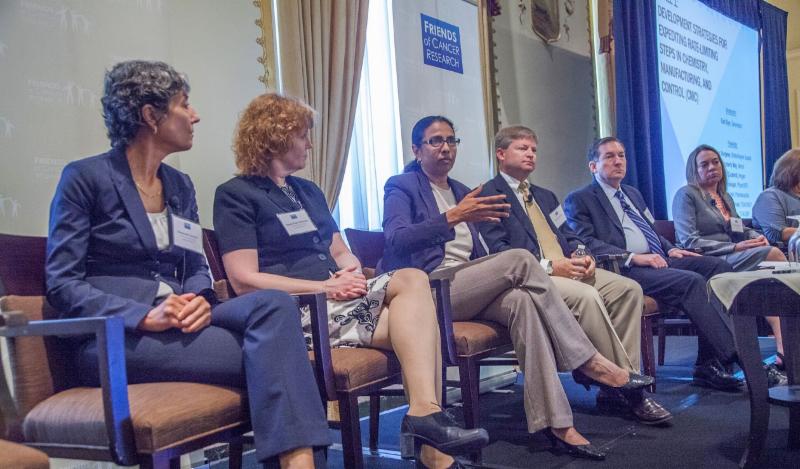
The multi-stakeholder forum, convened by Friends of Cancer Research (Friends), explored rate-limiting steps in manufacturing readiness for breakthrough drug development. Ellen Sigal, chairperson and founder of Friends, emphasized the importance of addressing and resolving the challenges in drug and process development and their impact on Breakthrough Therapy Designations (BTD): “If it’s not manufactured, there is no breakthrough.”
Panel 1: Development Strategies for Expediting Rate-limiting Steps in Chemistry, Manufacturing, and Control (CMC)

(R-L) Earl Dye, Emanuela Lacana, Sarah Pope Miksinski, Usha Ramesh, Joseph Gorskoph,
Keith Cockerill, Annie Sturgess
The first panel, moderated by Earl Dye, Genentech, explored options for manufacturers to front-load certain critical product and process characterization activities for breakthrough drug development in the context of real-life case studies. Each industry panelist identified challenges and mitigating steps in chemistry, manufacturing, and controls (CMC) activities that arose during development under the constrained timelines. For standard package submissions, CMC activities are typically completed first, however for BTDs, it’s the other way around, noted Usha Ramesh, Pharmacyclics. The case studies were diverse, encompassing BTDs both early and late in development, variable availability of resources, and product type (biologic versus small molecule). While each case study was unique, some common themes emerged; early planning, ensuring appropriate comparability, and open and transparent communications between the sponsor and FDA review team.
To ensure proper comparability, a sponsor needs to link products at different stages of development. As described by Emanuela Lacana, FDA, this may be facilitated by retaining appropriately stored samples from clinical trials to do comparability studies. Kimberly May, Merck, summarized the key to their success was “a strong commitment from not only the scientists, but key interactions with management support and open communication with the FDA.” The importance of establishing transparent and frequent communications with the FDA was echoed throughout the forum. Annie Sturgess, BMS, said the key for industry is to “look at the indication we’re going after” to determine the potential for breakthrough designation and use that in planning CMC development activities. Moreover, communicating with the Agency the sponsor’s intention to pursue breakthrough designation would also help to ensure proper planning and resource allocation measures are in place. With BTDs showing no signs of slowing down, the panel agreed, that the products approved may have more CMC related post-approval submissions since some activities may be deferred. This could create additional resource burdens for both industry and regulators. Thus, the open dialogues between sponsors and FDA may need to continue well after the initial approval in order to ensure adequate long term supply.

For small companies with limited resources, additional challenges exist, stated Dr. Ramesh, adding that small companies often rely heavily on contracting out many manufacturing activities. However, there are certain advantages to a smaller organization, such as, assembling all stakeholders at short notice for key decisions, allowing for great flexibility and promptness to respond to developing issues. These attributes were key to delivering product on the day of approval. Similarly, from the regulator perspective, ensuring resources are available for the review was the greatest challenge, Dr. Lacana noted. Often, review teams for breakthrough products involve significantly more review staff and internal meetings to ensure the fastest and clearest way to communicate issues with the sponsors. In response to “where do resource restrictions get in the way of moving study products forward?” Sarah Pope Miksinski, FDA, noted that without a set of systematic practices, reviewers often prioritize breakthrough applications, therefore diverting resources from non-breakthrough work, potentially delaying other filings. John Groskoph, Pfizer, observed that following standard procedures, an Agency response can take between 30 and 90 days, yet with a breakthrough review, “in one case we had our issues resolved within 48 hours”. Dr. Pope Miksinski added that, as designated in the Expedited Programs guidance, using senior management as conduits for sponsors is a viable approach to resolving issues quickly. With so much staff dedicated to breakthrough review, though, it is difficult to innovate and the Agency often relies on “retrofitting resources to fit new ideas.” For breakthrough drugs, some practices were adapted from previous best practices in pre-Breakthrough expedited reviews. Despite the resource strain, however, “we always put the patient first, and then try to fit everything we have to do to serve them best” Dr. Pope Miksinski noted. Ultimately, the panel agreed, the goal for both industry and FDA partners is that “quality should not be the rate-limiting step that a drug is not available to patients.”
Panel 2: Policy Implications for Industry and Regulatory Agencies
- Paul Seligman, Amgen (Moderator)
- Diane Zezza, Novartis
- Tim Watson, Pfizer/AAPS
- Tom O’Connor, FDA/OPQ
- Sarah Pope Miksinski, FDA/ONDP
- Chris Joneckis, FDA/CBER

Paul Seligman, Amgen, moderating the second panel, referred to the first 2-3 years of experience with the breakthrough designation as the “springtime of breakthrough.” Now, we need to address how best to incorporate the learnings from these initial experiences moving forward. Panelists expanded on discussions of risk taking, control strategies, ensuring global product supply, and developing robust processes for product development.
“Some decisions have to be made at risk,” but to assure product quality and rapid delivery to patients, certain risks can be managed in the post-approval setting, Tim Watson, Pfizer, noted. This would rely on an evaluation of “what is critical and what can be deferred without any risk to patients or quality” Diane Zezza, Novartis noted. Where possible, platform knowledge can be crucial to supplement and accelerate process or product characterization and mitigate risk. With biologics, while there are unique assays, such as potency, that do not lend themselves to platform technologies, Dr. Dye noted, there are instances where biologics could in fact leverage platform technologies; in the case of monoclonal antibodies, “there are platform technologies in terms of upstream cell culture processing and downstream purification processing” and analytical methods that could be used to apply to new molecules. Additionally, control strategies are critical for breakthrough products. Dr. Watson added, “if you don’t know your process, it’s not robust and can’t tolerate variability, you’ll have extensive, restrictive control strategies that probably risk your supply.”
To address global management of quality, panelists discussed existing programs. Many countries limit the ability to submit incomplete packages, particularly around stability data, posing many challenges, Dr. Dye described. Though the FDA does not directly engage with other regulatory agencies on quality, the U.S. breakthrough program has raised awareness worldwide of the numerous challenges associated with moving non-critical activities into the post-market setting. Management of these post-approval commitments, through global alignment, will hopefully become elucidated in the future.

(L-R) Paul Seligman, Tom O’Connor, Diane Zezza, Tim Watson, Chris Joneckis, Sarah Pope Miksinski
While it is understood that risks are sometimes taken in the absence of complete data sets, communication and transparency of the unknowns and the gaps have to be part of the package. FDA representatives echoed the importance of transparency, both within the Agency and with industry colleagues. Having a space for conversations between the Agency and sponsors, outside of the PDUFA time clock, of what worked and what didn’t work is a huge opportunity. Dr. Pope Miksinski noted that, at the FDA, “the idea that the work [the reviewers] do is visibly linked to the patients that it served” is something reviewers are excited about. Chris Joneckis, FDA, described instances of true public health concerns, where the FDA worked with product developers to move applications forward and delivered successful therapies.
In looking forward, as more Breakthroughs are designated and more experience and knowledge is gained with breakthrough drugs already on the market, incorporating lessons, in terms of review management, adequate resourcing, risk assessment, post-market commitments and lessons learned, will be the next steps. It will also be important to determine the resources needed to support robust and timely interactions between drug developers and regulators, and how these challenges will be addressed to ensure product availability and continuity.
Click Here to view the White Paper
